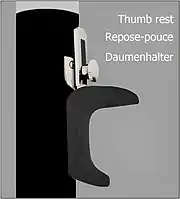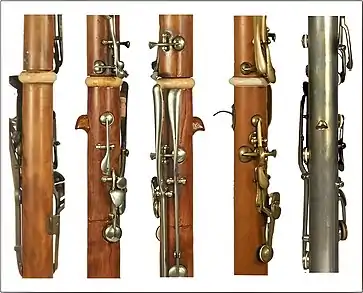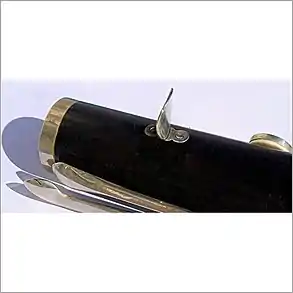
A thumb rest is a device that helps the player of certain woodwind instruments to keep them in the correct position and to facilitate his playing (embouchure, posture, fingerings). The instruments are mainly clarinets, oboes, saxophones and flutes.[1]
History
Historically, woodwind instruments were first made from boxwood and fruitwood; they were relatively compact and light, and they did not have a thumb rest.[2] The need arose from about 1830 with the increase in the number of keys in wind instruments and the switch to exotic woods, especially grenadilla from Mozambique, which made the instruments heavier.[3]
Around 1860, the co-inventor of the Boehm clarinet Hyacinthe Klosé made the thumb rest generally accepted in France by means of his méthode complète de clarinet, after he too had switched to making his clarinets from grenadilla.[4][5]
The thumb rest was either carved from the solid wood or screwed onto the body of the instrument as a metal part.[6] The clarinetist and clarinet maker Iwan Müller is considered the inventor of the thumb rest.[7][8] In fact, however, it was developed independently by various woodwind instrument makers. In the time before that, many clarinettists put the mouthpiece on the clarinet in such a way that the reed was on top (over-blowing instead of the under-blowing with the reed on the lower lip that is common today), because they could hold the instrument better that way.[9][10]
The saxophone has had a thumb rest since its creation in 1849.[11][12] The Selmer Mark VI saxophone model from Henri Selmer Paris, which revolutionised the ergonomics of this instrument when it was introduced in 1954, had an adjustable thumb rest made of plastic or metal.[13]
The side of the thumb rest that comes into contact with the finger is usually fitted with a glued-on cork or rubber pad to protect the finger. Some musicians develop a callus in this contact area.[14] Some thumb rests have a device that allows the use of a strap to relieve the thumb.[12]
Support on the bassoon
Instead of a thumb rest, bassoonists use a hand rest on the German bassoon (Heckel system).[15][16] The French bassoon does without one. [17]
Thumb rests and musculoskeletal disorders
To counter musculoskeletal disorders (chronic pains), there are now ergonomic thumb rests that distribute the weight of the instrument over the whole thumb and/or the thumb and wrist.[18][19] Some of these supports can also be combined with a strap.[20]
Gallery
 Different models of thumb rest on historical clarinets (from left): without rest, wooden rest, metal rests
Different models of thumb rest on historical clarinets (from left): without rest, wooden rest, metal rests.jpg.webp) Alto saxophone by Adolphe Sax with thumb rest (1855)
Alto saxophone by Adolphe Sax with thumb rest (1855) Screwed thumb rest made of nickel silver of an Albert system clarinet (ca. 1900)
Screwed thumb rest made of nickel silver of an Albert system clarinet (ca. 1900).jpg.webp) Adjustable support on a basset clarinet
Adjustable support on a basset clarinet.jpg.webp) Ergonomic thumb rest Étude by Ton Kooiman, with perforated leather stripe for carrying strap
Ergonomic thumb rest Étude by Ton Kooiman, with perforated leather stripe for carrying strap.jpg.webp) Bassoon (Heckel system) showing right hand on handrest in playing position
Bassoon (Heckel system) showing right hand on handrest in playing position.jpg.webp) French bassoon without handrest
French bassoon without handrest
References
- ↑ "Instruments". Ton Kooiman, Woodwind Ergonomics. Retrieved 21 November 2022.
- ↑ Young 2014, p. 13.
- ↑ Young 2014, p. 14.
- ↑ "History of the clarinet". Henri SELMER Paris. 27 June 2019. Retrieved 21 November 2022.
- ↑ Young 2014, p. 16.
- ↑ Young 2014, pp. 9–10.
- ↑ Angloher 2007, p. 23.
- ↑ "Development of the Clarinet - Clarinet Study with Greg Barrett". Northern Illinois University. Retrieved 21 November 2022.
- ↑ Young 2014, p. 4.
- ↑ Angloher 2007, p. 24.
- ↑ Shanoff et al. 2019.
- 1 2 Young 2014, p. 12.
- ↑ "Selmer MkVI tenor saxophone review". Stephen Howard Woodwind. Retrieved 21 November 2022.
- ↑ Stock, Robert W. (31 July 1983). "Pied Piper of the Clarinet". The New York Times. New York City. Retrieved 21 November 2021.
- ↑ Garcia 2011.
- ↑ "Bassoon". Wilhelm Heckel GmbH. 16 December 2018. Retrieved 21 November 2022.
- ↑ Kiss, Beatrix (14 April 2003). "Die Entwicklung des Fagotts, im besonderen die Entwicklung des französischen Systems (The development of the bassoon, in particular the development of the French system)" (in German). UNIVERSITÄT FÜR MUSIK UND DARSTELLENDE KUNST IN WIEN. p. 29. Retrieved 21 November 2022.
- ↑ Young 2014, pp. 27–28.
- ↑ Young & Winges 2017.
- ↑ Young 2014, p. 136.
Sources
- Angloher, Stephanie (2007), Das deutsche und französische Klarinettensystem (PhDThesis) (in German), Ludwig-Maximilians-Universität München, doi:10.5282/EDOC.7344, retrieved 21 November 2022
- Garcia, N.A. (2011). The Ergonomics of Playing Bassoon: A Natural and Stress Free Approach to Playing the Instrument. University of Cincinnati. Retrieved 21 November 2022.
- Shanoff, Chelsea; Kyurim, Kang; Guptill, Christine; Thaut, Michael (2019). "Playing-Related Injuries and Posture Among Saxophonists". Medical Problems of Performing Artists. Science and Medicine, Inc. 34 (4): 215–221. doi:10.21091/mppa.2019.4032. ISSN 0885-1158. PMID 31800673. S2CID 208642580.
- Young, Kathryn E; Winges, Sara A (1 June 2017). "Thumb-Rest Position and its Role in Neuromuscular Control of the Clarinet Task". Medical Problems of Performing Artists. Science and Medicine, Inc. 32 (2): 71–77. doi:10.21091/mppa.2017.2013. ISSN 0885-1158. PMID 28599013.
- Young, Kathryn (2014). Clarinet Thumb-rest Function: The Pedagogy of Positioning and Electromyography Evidence (Thesis). Louisiana State University Libraries. doi:10.31390/gradschool_dissertations.691.
Patents
- US 2803983, Dowling, Clem, "Thumb rest for clarinets or other musical instruments", published 1957-08-27
- US 3988958, Brunkow, Darwin D., "Thumb rest for a musical wind instrument", published 1976-11-02
- US 4348935, Bay, Charles L., "humb rest for woodwind musical instruments", published 1982-09-14